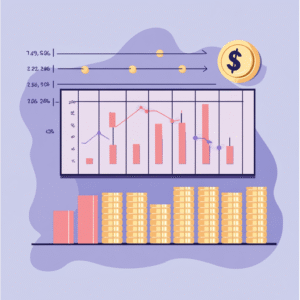1. Introduction
DRIPs Demystified Maximize Compounding offers investors a simple yet powerful way to harness the magic of compounding by automatically reinvesting dividends into additional shares. Rather than receiving cash payouts that might languish in a checking account or tempt you toward impulsive trades, a dividend reinvestment plan (DRIP) ensures every dollar funnels back into your portfolio, steadily growing your stake and multiplying returns over time. I first experienced this effect when I enrolled in a DRIP for a blue-chip utility stock: within five years, my position had doubled in share count, and the growing dividend checks created a snowball of reinvestment. In this guide, we’ll explore the mechanics behind DRIPs, detail the benefits and potential pitfalls, and walk through setting up plans, selecting high-quality dividend stocks, understanding tax rules, and employing advanced strategies to further accelerate growth. By the end, you’ll feel confident leveraging DRIPs to cultivate a robust, compounding-driven portfolio.
2. What Are DRIPs and Why They Matter
Dividend Reinvestment Plans (DRIPs) are programs—often offered by publicly traded companies or brokerage firms—that automatically use your dividend payments to purchase additional shares of the same stock, typically without commissions or fees.
2.1 Direct-Company vs. Broker-Managed DRIPs
Direct-company DRIPs run through the issuer’s transfer agent and sometimes offer discounted share prices (1–5% below market). Broker-managed DRIPs reinvest dividends in your existing brokerage account, keeping all holdings in one place but sometimes charging small fees. Compare both to choose the best fit.
2.2 Fractional Shares and Compounding
Unlike standard purchases, DRIPs allow fractional-share acquisitions, so even tiny dividends get reinvested fully. Over time, as share counts increase, subsequent dividends rise as well—creating a snowball effect where dividends yield dividends, exemplifying DRIPs Demystified Maximize Compounding in action.
2.3 Why It Beats Cash Payouts
Holding dividends in cash tempts many toward market timing or impulse trades. DRIPs remove that temptation, enforcing a buy-and-hold mindset. With every payout, your stake grows, your yield on cost climbs, and you benefit from downturns by purchasing more shares at lower prices.

Understanding this cycle is the foundation of DRIPs Demystified Maximize Compounding—ensuring your portfolio grows more robust with each distribution.
3. Key Benefits of Dividend Reinvestment Plans
One of the most powerful aspects of DRIPs is the automatic compounding effect: every dividend payment buys additional shares (or fractions), so your portfolio grows on both your original investment and every prior reinvestment. Over decades, even modest yields become significant contributors to total return, smoothing the impact of market swings and rewarding patience.
DRIPs often come with added perks that amplify your effective yield. Many plans offer share-purchase discounts of 1–5 % off the market price and waive all commission fees on reinvestments, eliminating transactional drag that can erode small purchases. Participating directly through the issuing company sometimes unlocks shareholder benefits—annual reports, special reinvestment share classes, or even voting rights on future program enhancements.
Internally, you can deepen your understanding by exploring our guide to dividend stocks.
4. Setting Up Your First DRIP
To enroll in a DRIP, start by confirming whether your chosen dividend-paying company offers a direct plan. Visit the investor relations section of their website and locate “Dividend Reinvestment Plan” or “DRIP Enrollment.” You may need to fill out an online application or mail a signed form, providing your brokerage details or opening a direct registration account.
Once registered, dividend checks will automatically convert into share purchases at the plan’s designated reinvestment date. Many DRIPs allow optional cash investments—letting you add funds between dividend dates to buy extra shares. Take advantage of this feature during market dips to accelerate compounding.
If your broker supports automated reinvestment, you can often set up a DRIP via your account dashboard. Compare company-run plans versus brokerage DRIPs: direct plans may offer discounts and fractional shares, while broker-managed plans ensure all holdings stay in one place for easy oversight.
5. Choosing the Best Dividend Stocks for DRIPs
Not all dividend payers are ideal DRIP candidates. Start by targeting companies with at least ten consecutive years of dividend increases and strong free cash flow that can sustain payouts during downturns. Look for modest payout ratios—typically below 60 %—to ensure room for growth and reduce the risk of future cuts.
6. Tax Implications and Record-Keeping
6.1 Tax Treatment of DRIP Dividends
In most jurisdictions, dividends reinvested via a DRIP are treated as ordinary income on the ex-dividend date—even if you never touched the cash. You must declare the fair market value of the shares purchased by your plan as income. Later, when you sell those shares, your capital gain or loss equals the difference between the sale proceeds and the accumulated cost basis (initial purchase plus every reinvested dividend). Fractional shares are no exception: each fraction has its own cost basis that must be tracked.
6.2 Structuring Your Records
Over decades, DRIPs generate hundreds of small transactions. To stay organized:
• Maintain a spreadsheet logging ex-dividend dates, share quantities, and market prices.
• Save plan statements and trade confirmations—most plan administrators archive these online.
• Consider specialized software (e.g. portfolio–tracking apps) that automatically imports DRIP lots and calculates cost basis for tax reporting.
6.3 International Variations and Professional Advice
Tax rules vary widely: some countries allow dividend tax credits, others impose withholding taxes on foreign issuers. If you hold international DRIPs, you may need to claim foreign tax credits or file additional forms. For peace of mind, consult a tax advisor experienced in dividend taxation and DRIP plans. Proper guidance turns a complex year-end filing into a routine exercise rather than a daunting chore.
7. Monitoring and Analyzing DRIP Performance
Regular review validates that your DRIP accelerates your goals. Track these metrics:
Yield on Cost (YOC): Annual dividends relative to your original cost basis; should climb as shares accumulate.
Total Return Comparison: Compare DRIP-enhanced returns against a non-reinvested income portfolio.
Dividend Growth Rate: Annual percentage increase in dividend per share, indicating sustainable payout growth.

Use brokerage analytics or your own dashboards to visualize how DRIPs Demystified Maximize Compounding outperforms alternative approaches over time.
8. Advanced Compounding Strategies
8.1 Dollar-Cost Averaging into Your DRIP
Beyond automatic reinvestment, you can inject fresh capital on a schedule—weekly, monthly, or quarterly—into your DRIP to average into your positions over market cycles. This extra layer of discipline smooths out volatility: you buy more shares when prices dip and fewer when prices rise, enhancing your long-term compounded returns.
8.2 Covered Call Overlays
Leverage your growing share balance by writing covered calls against a portion of your DRIP shares. The premiums you collect can be funnelled back into additional DRIP purchases, effectively supercharging your compounding engine. With careful strike and expiration selection, you generate extra income without significantly increasing downside risk.
8.3 Tactical Portfolio Rebalancing
Quarterly, trim positions that exceed target allocations and redeploy proceeds into underweighted high-quality dividend payers, preserving diversification and compounding power.

These advanced maneuvers amplify DRIPs Demystified Maximize Compounding, turning a simple reinvestment plan into a dynamic wealth engine.
8.4 Additional Learning
If you’re looking for information and tips on how to safely invest in the cryptocurrency market, this comprehensive program is designed to equip you with the knowledge and tools you need to identify and invest in the most promising cryptocurrencies. Cryptocurrencies have revolutionized the financial landscape, offering both unique opportunities and significant risks. With thousands of digital currencies available, only a few have the potential to guarantee long-term financial success. This course will guide you through understanding, analyzing, and investing in the top 1% of cryptocurrencies that are poised to thrive.
9. Common Mistakes and How to Avoid Them
9.1 Ignoring Dividend Cuts
One of the fastest ways to derail a DRIP strategy is to overlook when a company trims or suspends its dividend. I once held a utility stock that cut its payout unexpectedly during a downturn, and my reinvestment snowball froze overnight. To avoid this, monitor companies’ earnings calls and payout ratios regularly. Set an alert for any dividend announcements, and have a plan to pause reinvestment if a cut seems likely.
9.2 Overconcentration in a Single Stock
Letting one high-yield stock dominate your DRIP portfolio can amplify risk. Even stalwarts like consumer staples can falter if industry dynamics shift. I learned this the hard way when one bank’s sector-wide regulatory change slashed its dividend, denting my otherwise solid returns. Diversify across at least five to seven dividend payers in different sectors—utilities, healthcare, consumer goods—to cushion your compounding engine against idiosyncratic shocks.
9.3 Underestimating Fees and Purchase Discounts
Not all DRIPs are fee-free or discounted. Some broker-managed plans charge small commission fees on reinvestments, which can erode returns over decades of tiny transactions. Conversely, company-run DRIPs often provide a 1–5% discount on share purchases. Before enrolling, compare fees and discounts: even a 2% difference compounds dramatically over time. I keep a simple spreadsheet to track net reinvestment costs versus discounts to ensure I’m maximizing every dividend dollar.
9.4 Poor Record-Keeping
Over twenty years, DRIPs can generate hundreds of micro-transactions—each with its own cost basis. Without meticulous records, tax filings become nightmarish and you risk misreporting gains or losses. After struggling with paper statements, I switched to a portfolio-tracking app that automatically logs every reinvestment lot and calculates cost basis. Whether you use software or a detailed spreadsheet, log ex-dividend dates, share counts, and reinvestment prices immediately to maintain clarity.
9.5 Chasing Yield at the Expense of Quality
It’s tempting to pile into the highest-yielding DRIPs, but sky-high yields often signal financial stress. A company with a 10% dividend yield may be struggling to sustain that payout. Focus instead on firms with moderate, steadily growing dividends—those that have increased payouts for 10+ consecutive years. This discipline ensures your reinvestment plan builds on stable foundations, letting compounding work its magic rather than chasing fleeting, high-risk yields.
By recognizing and proactively addressing these common pitfalls—dividend cuts, concentration risk, hidden fees, record-keeping lapses, and reckless yield chasing—you’ll keep your DRIP strategy on track and let the true power of compounding shine through.
10. Conclusion
DRIPs Demystified Maximize Compounding reveals how a simple election—to reinvest instead of withdraw—can transform modest dividend yields into a formidable wealth-building engine over time. By understanding plan structures, selecting resilient dividend payers, maintaining precise tax records, and layering advanced tactics like dollar-cost averaging and covered calls, you empower your portfolio to grow steadily and sustainably. The real power lies in starting early: every share purchased through reinvestment not only adds tomorrow’s dividends but compounds on prior payouts, creating exponential growth that rewards patience and consistency. Embrace DRIPs as the cornerstone of your long-term strategy, and watch passive income snowball into significant financial freedom.
12. FAQ
12.1 How Do I Get Started with DRIPs?
Begin by identifying dividend-paying companies that offer direct DRIP enrollment—check the investor relations page on their website. Complete the online application or mail the enrollment form, and set up your dividend payments to be automatically reinvested. If your broker supports DRIPs, enable automatic reinvestment in your account settings. Start small—choose one or two blue-chip stocks with strong payout histories—to learn the mechanics before expanding your plan.
12.2 What Capital Is Ideal for a DRIP Portfolio?
You don’t need a large sum to begin. Even $500–$1,000 invested across two or three quality dividend payers can illustrate the power of compounding. As dividends accrue and reinvest, your position grows. Over time, consider increasing your monthly contributions or adding cash-in-DRIP options if your plan allows, but always keep your total DRIP allocation within a comfortable percentage of your overall portfolio (e.g., 10–20 %).
12.3 Which Metrics Should I Track?
Key performance indicators include:
• Yield on Cost (YOC): Dividend yield calculated on your original investment basis, which rises as shares accumulate.
• Annualized Total Return: Compare DRIP returns against a non-reinvested dividend strategy.
• Dividend Growth Rate: Track year-over-year increases in payouts to ensure companies continue raising dividends.
Use your broker’s analytics dashboard or a simple spreadsheet to chart these metrics quarterly.
12.4 How Are DRIP Dividends Taxed?
Reinvested dividends are taxable as ordinary income in most jurisdictions at the fair market value on the ex-dividend date. You must report each reinvestment as income, then adjust your cost basis accordingly for future capital gains calculations. Maintain detailed records of dates, share amounts, and values. Consider tax software or a professional advisor to handle multiple micro-transactions and avoid surprises at tax time.
12.5 What Common Mistakes Should I Avoid?
• Overconcentration: Don’t let one high-yield stock dominate—diversify across sectors.
• Ignoring Cuts: Monitor company health and payout ratios to anticipate dividend reductions.
• Fee Overlook: Compare plan fees and purchase discounts to maximize net reinvestment.
• Poor Record-Keeping: Log every reinvested lot immediately to simplify tax reporting.
12.6 How Can I Continue Learning?
Stay informed by following dividend-focused investor forums, subscribing to reliable financial newsletters, and reviewing annual reports from companies in your DRIP. Periodically revisit our guides on Dividend Stocks: The Secret to Long-Term Wealth to refine your approach and ensure your DRIP strategy remains aligned with evolving market conditions.
